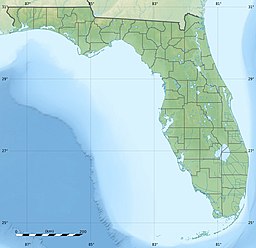geo.wikisort.org - Reservoir
Lake Harney, named for General William S. Harney, is a lake that straddles the county line between Volusia County and Seminole County, Florida, at the coordinates latitude 28°45’21.404", longitude 81° 03’36.019". It is fed by the Saint Johns River which flows through central Florida and feeds many of the nearby lakes such as Lake Monroe.
| Lake Harney | |
|---|---|
| Location | Volusia and Seminole Counties, Florida |
| Coordinates | 28.755946°N 81.060003°W |
| Type | Flow-through lake |
| Primary inflows | St. Johns River, Black Cypress Swamp |
| Primary outflows | St. Johns River |
| Basin countries | United States |
| Managing agency | St. Johns River Water Management District |
| Max. length | 4.8 mi (7.7 km) |
| Max. width | 2.97 mi (4.78 km) |
| Surface area | 9 sq mi (23 km2) |
| Average depth | 7 ft (2.1 m) |
| Max. depth | 15 ft (4.6 m) |
| Water volume | 14,465,351,103 US gal (44,400 acre⋅ft; 54.8 hm3) |
| Shore length1 | 12 mi (19 km) |
| Surface elevation | 0 ft (0 m)[1] |
| Islands | 2 islands and numerous islets, all along the shore |
| Settlements | Lake Harney Woods, an unincorporated community[2] |
| 1 Shore length is not a well-defined measure. | |
History
A large amount of Lake Harney's history can be credited to General William S. Harney and the wars he took part in throughout Florida. Mal Martin, in a 2001 online article, "The Naming of Lake Harney", stated, "William Selby Harney was born in Haysboro, Tennessee, on August 22, 1800."
When he entered the military, he enlisted as a Second Lieutenant in the First United States Infantry on February 12, 1818, and remained at that rank throughout the First Seminole War which was sparked by Andrew Jackson's attack on a fort held by the Seminole people. Harney was recognized for his military abilities and raised to the rank of First Lieutenant, on January 7, 1819.
Harney continued in his military career and, after the end of the Second Seminole War, served in the Mexican–American War and the Civil War, retiring on August 1, 1863, as a General. After retirement, he married a nurse and lived in Pass Christian, Mississippi, for some time. He died on May 9, 1889, in Orlando, Florida, and was buried at Arlington National Cemetery.
There are several landmarks named in his honor, such as Harney Peak (now Black Elk Peak) in South Dakota and Camp Harney in Zapata, Texas.
Wildlife
Lake Harney is home to a variety of species of fish, reptiles, water fowl and wading birds. It is nominally fresh water with some salt water springs throughout the area. The lake is home to a variety of fish such as largemouth bass, crappie, bluegill, and redear sunfish, all of which are prey to the lake's birds such as bald eagles, osprey, Crested caracara, white ibis, wood stork (Ibis), herons, cranes, cattle egrets, wild turkeys, a variety of ducks and other water fowl. The Lake Harney Wilderness Area is a protected habitat in which the Florida Fish and Wildlife Conservation Commission, or FWC, observes several bald eagle nests in the area.
References
- AnyplaceAmerica.com website, at https://www.anyplaceamerica.com/directory/fl/volusia-county-12127/lakes/lake-harney-283749/ .
- Lake Harney Woods Property Owners Association website, at http://www.lakeharneywoodspoa.com/lakeharney/home.asp .
- St. Johns River Water Management District watershed facts: Lake Harney[permanent dead link]
- Seminole County water atlas: Harney, Lake at University of South Florida
- Lake Harney at University of South Florida
- The Naming of Lake Harney at USGenNet.org
- Seminole County rules of use
Другой контент может иметь иную лицензию. Перед использованием материалов сайта WikiSort.org внимательно изучите правила лицензирования конкретных элементов наполнения сайта.
WikiSort.org - проект по пересортировке и дополнению контента Википедии

